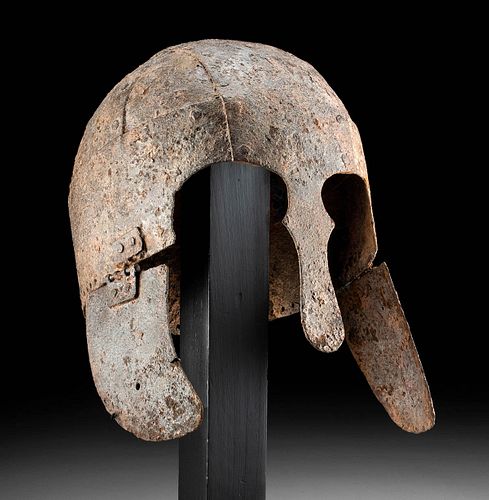Rare Anglo-Saxon Iron Helmet w/ Nose Guard & Ear Flaps
Lot 51b
About Seller
Artemis Fine Arts
686 S Taylor Ave, Ste 106
Louisville, CO 80027
United States
Selling antiquities, ancient and ethnographic art online since 1993, Artemis Gallery specializes in Classical Antiquities (Egyptian, Greek, Roman, Near Eastern), Asian, Pre-Columbian, African / Tribal / Oceanographic art. Our extensive inventory includes pottery, stone, metal, wood, glass and textil...Read more
Categories
Estimate:
$10,000 - $15,000
Absentee vs Live bid
Two ways to bid:
- Leave a max absentee bid and the platform will bid on your behalf up to your maximum bid during the live auction.
- Bid live during the auction and your bids will be submitted real-time to the auctioneer.
Bid Increments
| Price | Bid Increment |
|---|---|
| $0 | $25 |
| $300 | $50 |
| $1,000 | $100 |
| $2,000 | $250 |
| $5,000 | $500 |
| $10,000 | $1,000 |
| $20,000 | $2,500 |
| $50,000 | $5,000 |
| $100,000 | $10,000 |
| $200,000 | $20,000 |
About Auction
By Artemis Fine Arts
Oct 8, 2020
Set Reminder
2020-10-08 10:00:00
2020-10-08 10:00:00
America/New_York
Bidsquare
Bidsquare : Exceptional Antiquities, Asian, Ethnographic
https://www.bidsquare.com/auctions/artemis-gallery/exceptional-antiquities-asian-ethnographic-5796
Museum-worthy examples of Egyptian, Greek, Roman, Etruscan, Near Eastern, Far East / Asian, Pre-Columbian, African / Tribal,Oceanic, Native American, Spanish Colonial, Russian, Fossils, Ancient Jewelry, Fine Art, so much more! Artemis Fine Arts info@artemisfinearts.com
Museum-worthy examples of Egyptian, Greek, Roman, Etruscan, Near Eastern, Far East / Asian, Pre-Columbian, African / Tribal,Oceanic, Native American, Spanish Colonial, Russian, Fossils, Ancient Jewelry, Fine Art, so much more! Artemis Fine Arts info@artemisfinearts.com
- Lot Description
Western Europe, Great Britain, England, Anglo-Saxon, ca. 6th to 8th century CE. A wonderful Anglo-Saxon iron helmet constructed with two broad panels that intersect over the top of the domed form. A lengthy nose guard is integral with the front of the vertical panel and has a pair of protruding points that give the impression of relatively rounded eye holes. Additional iron plates are riveted in place along the underside to create an enclosed armor piece, and a pair of ear flaps drape from the lateral peripheries. Anglo Saxon helmets, like Danish and Viking examples, had a conical shape in order to protect the wearer's head by deflecting direct blows. The most expensive helmets, used by kings and nobles, were made entirely of steel and iron while less expensive examples had an iron 'skeleton' to which panels of animal horn, hard leather, or even wood were affixed. Size: 7.375" W x 11" H (18.7 cm x 27.9 cm); 17.25" H (43.8 cm) on included custom stand.
The Saxons were fierce, bearded warriors who fought with a ruthless and unreserved attack style that intimidated many, even the Romans. Anglo-Saxon society revolved around warfare. Freemen were automatically warriors and were expected to fight from early adolescence. Teenage boys were often taken into a chieftain's household to be trained as warriors. Anglo-Saxon warriors were equipped with javelins and throwing axes as well as swords and shields. In particular a "scramasax" - a single-bladed dagger - was used for close-quarter fighting. Gesiths (serving-men and companions to the king) fought for their hlaford (lord/ breadgiver). Freemen were rewarded for their military service with (at first generally temporary) grants of land. The need to obtain more land for distribution encouraged policies of conquest, and the kings of Wessex were particularly successful, because they were able to expand into Cornish territory. One of the most legendary was Alfred the Great, the King of Wessex from 871 to 899, who defended his kingdom against the Viking attempt at conquest and by the time of his demise had become the dominant ruler of England. For these reasons, he was the only English monarch accorded the epithet "the Great". The epithet was retained by succeeding generations of Parliamentarians and empire-builders who saw Alfred's patriotism, success against barbarism, promotion of education and establishment of the rule of law as supporting their own ideals.
Provenance: ex-estate of Eldert Bontekoe, Pegasi Numismatics, Ann Arbor, Michigan, USA, acquired before 2000
All items legal to buy/sell under U.S. Statute covering cultural patrimony Code 2600, CHAPTER 14, and are guaranteed to be as described or your money back.
A Certificate of Authenticity will accompany all winning bids.
We ship worldwide and handle all shipping in-house for your convenience.
#158566One ear flap is unattached from hinges and is displayed on an auxiliary arm as shown. Second ear flap is attached only by one hinge ring. Slight bending to overall form of helmet periphery, nose guard, and ear flaps, with light encrustations and pitting in several areas. Great iron patina throughout.Condition
- Shipping Info
-
All shipping is handled in-house for your convenience. Your invoice from Artemis Gallery will include shipping calculation instructions. If in doubt, please inquire BEFORE bidding for estimated shipping costs for individual items.
-
- Buyer's Premium



 EUR
EUR CAD
CAD AUD
AUD GBP
GBP MXN
MXN HKD
HKD CNY
CNY MYR
MYR SEK
SEK SGD
SGD CHF
CHF THB
THB
















